
Manufacturer's Specifications:
Frequency Response: 30 Hz to 19 kHz, to 20 kHz with CrO2 tape, to 21 kHz with metal tape.
Signal/Noise Ratio: 67 dB, CCIR/ ARM weighted.
Separation: 40 dB.
Crosstalk: -65 dB.
Input Sensitivity: Mike, 0.35 mV; line, 70mV
Output Level: Line, 775 mV; head phone, 1.2 milliwatts.
Flutter: 0.04% W rms.
FF& RWD Times: 90 S for C-60.
Dimensions: 17 in. (434 mm) W x 4.6 in. (117 mm) H x 11.8 in. (300 mm) D.
Weight: 15.4 lbs. (7.0 kg).
Price: $500.00.

Denon is one of Japan's oldest producers of professional tape recording equipment, with more than three decades of experience in the field. Their machines are seen not only in the broadcast rooms of the Japanese government's NHK stations but also those of privately held stations, and they were one of the first companies to adapt digital or PCM technology to audio recording.
The Denon DR-330 cassette deck combines very good performance and a number of useful features with an attractive appearance for a medium price. The black lettering on the brushed aluminum front panel is quite easy to read, even in dim room light. The cassette compartment door opens smoothly with a push of the eject button, Loading is a simple drop-in, and there is good access for maintenance tasks, particularly with the clear window door snapped off. Worthy of note is the record-head/ playback-head assembly for off-the-tape monitoring while re cording. The light-touch tape-motion pushbuttons have helpful status lights for Play, Record and Pause/Mute, which last per forms in a special way. It gives the expected pause for either play or record functions, but if held in while in the Record mode, it mutes the incoming signal (still indicated on the meters if in Source), thereby recording a blank space until releasing puts the deck in Pause/Record. This is a good scheme, making one button do what requires two on most other decks. There are also forward and reverse Cue buttons which are effective from any mode, allowing relatively fast winding to the beginning or end of a piece. Holding a button in permits winding past any number of selections, and a status light indicates the location of any music (On) or blank sections (Off). This is a less involved design than some, straightforward and easy to understand.
The Denon DR-330 incorporates a Tape Tension Servo System (TTSS), which is designed to maintain a constant and stable tape-to-head contact pressure, and a non-slip reel-motor drive system, which is intended to add to transport stability by eliminating clutches, belts, etc. A sensing arm in the TTSS is inserted in the tape path and feeds information back to the supply motor so that tape tension is kept within fairly strict limits. The reel drive system is similarly electronically controlled. Examination of the drive system led to the conclusion that it was stable and rigid, with the quartz-lock PLL servo motor and large capstan flywheel most impressive.
The two VU-type meters are very well illuminated, scaled up to " +6" with the Dolby-level reference symbol at " +3." There are three peak-responding LEDs between the meters: Green for zero, orange for " +5" and red for " +8," making for a good combination of record-level metering. The monitor switch just below (a convenient location) has associated indicators: Orange for Source and green for Tape. The inclusion of such indicators is desirable, so it was a little surprising that there was none for the Dolby-NR On condition. The multiplex filter in/out switch is a separate pushbutton. There are similar buttons for timer start: One for Record with power turn-on, the other for Play. The tape counter has a reset button, but the deck has no memory function, which would be nice to have even with the included cue system.
Bias Fine Adjust is an important feature of this Denon deck, and there is a useful detent at zero for the control. Tape Select has four positions, including one for FeCr. There is an output level control, sometimes needed for good matching to the rest of a system and essential for headphone listening. Better index marks would minimize possible errors in the above three functions; tie knobs might also be on the small side for some, especially the rotary tape-select switch. In contrast, the dual-section input-level pots have large knobs with fine knurling and "just-right" friction between sections. Use of the mike jacks just below does not disconnect the line inputs. The line-power and eject pushbuttons and jacks for phones and remote control are at the opposite end of the panel.
Measurements
The playback responses were similar for both 70- and 120-uS equalizations: Accurate for most frequencies, but rolled off a few dB at the high end. The play-level meter indications were within 0.5 dB, and play speed was just 0.2% fast. The record/ playback responses were made at Dolby level and at 20 dB below that using Denon DX3 (Type I), DX7 (Type II), DX5 (Type III) and DXM (Type IV). Many other formulations could be well matched to the deck using the bias trimmer. The best results with these other tapes were obtained with Scotch Master II, Sony FeCr, Memorex Metal IV and TDK MA-R, with TDK AD, OD and SA, BASF Professional II, Sony EHF and Metallic, Osawa FC, Scotch Master III and Metafine, and Fuji Metal not far behind.
The best results with the Denon tape came with bias set very closely to that recommended in the instruction manual.
Figures 1 to 4 and Table I show the swept responses and list the.3 dB down points with and without Dolby NR. In general, the responses have very good flatness from 100 Hz to over 10 kHz and excellent Dolby tracking. There is some rise in the response around 3 kHz with DX5, more so with Dolby NR than without.
The results, however, are quite superior to those obtained with most Type III formulations on most cassette decks. The superiority of the DXM metal tape is most evident in the headroom extension at Dolby level.
With DX7 tape, the bias trimmer could be set for response anywhere from +1.8 to-4.5 dB at 10 kHz, from minimum to maximum setting. Response of the FM multiplex filter was 1 dB down at 15.4 kHz and had its maximum attenuation of 38.4 dB right at 19.00 kHz --the best observed to date. Bias in the output during recording was very low. With a 1-kHz test tone, separation was 50 dB, and crosstalk and erasure were down at least 80 dB --all excellent figures. Erasure of metal tape at 100 Hz was at least 73 dB, also excellent.
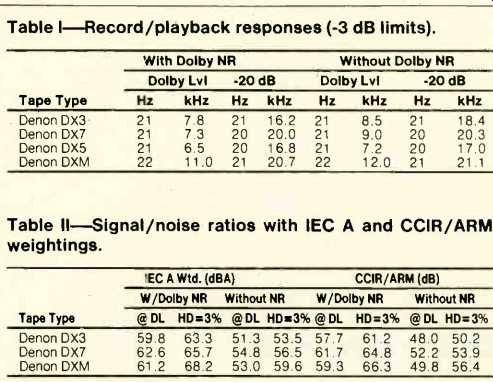
Table I--Record/playback responses (-3 dB limits). Table II--Signal/noise
ratios with IEC A and CCIR/ARM weightings.
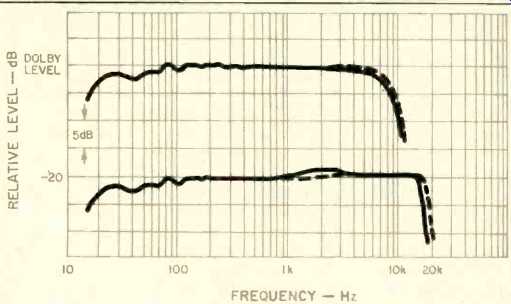
Fig. 1--Frequency responses with Denon DX3 tape with and without (---)
Dolby NR.
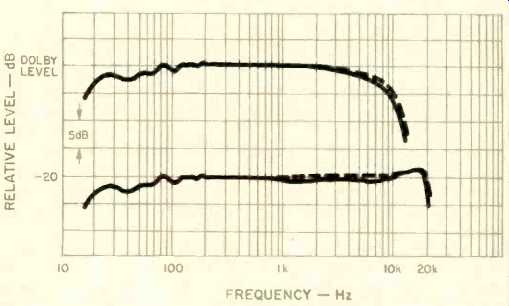
Fig. 2--Frequency responses with Denon DX7 tape with and without (---)
Dolby NR.
Fig. 3--Frequency responses with Denon DX5 tape with and without (---) Dolby NR.
The third harmonic distortion level, HDL3, was measured with, a 1-kHz tone in Dolby mode from -10 dB to that level resulting in HDL3 = 3%. The results for the Type I, II and IV tapes are plotted in Fig. 5. The excellent performance of DXM over the entire range is quite evident, although DX3 had the lowest distortion below -5 dB re: Dolby level. The three-percent points for DX3 and DX7 were not as impressively high as with DXM; how ever, the level used would actually be 1 dB above the " +6" maximum on the meter. The level of HDL3 measured with DXM tape in Dolby mode at a record level of -10 dB is plotted in Fig. 6. These results are superb--less than 0.2% distortion at the frequency extremes, less than 0.07% distortion in midband, and the most unusual 0.016% result at 2 kHz. As the data were not continuous with frequency, the exact curve is in doubt --indicated with the dashed line. A number of points were checked and rechecked, with consistent data in each case.
Signal-to-noise ratios were determined for the DX3, DX7 and DXM tapes with and without Dolby NR, both IEC A and CCIR/ ARM weightings. All of these results for both Dolby level and the HDL3 = 3% points are listed in Table II. The perceptive reader may note that there is usually a larger difference between Dolby level figures and 3% limit figures when in Dolby mode than without NR. This is just one indication that there is less distortion with Dolby for most recorders over a range of levels. In any event, the results are excellent, particularly with DX7 and DXM tapes.
Input sensitivities were 0.35 mV for mike, exactly to specification, and 62 mV for line, better than spec. Input overloads were plenty high: 75 mV for mike and over 30 V for line. The line input impedance was 54 kilohms at midband, falling somewhat at the highest frequencies. The output clipping point was at a level equivalent to +14.5 meter indication. The two sections of the input level control tracked adequately for most purposes.
The line output was exactly to spec. The headphone drive was more than adequate for any of the headphones tried. The line output impedance was very low (good), less than 200 ohms over the entire band. The output level pot sections tracked within a dB for only about 15 dB down from maximum, rather marginal in performance if level matching to another unit is required. The response time was a little short for a VU meter, reaching 0 dB with a burst of 180 mS. With the standard burst of 300 mS, there was about 1.5 dB overshoot. Scale accuracy was quite good, better than most. The peak-level indicators had thresholds that were exactly as designated, a well-implemented feature.
Flutter was checked both to wtd. pk. and W rms standards.
Each trial was separated from the next by using combinations of tape-motion controls to jiggle the tape around before the next check. The Denon deck was unusual in that the results were very consistent, no matter what was done: Excellent figures of 0.06% wtd. pk. and 0.04% W rms. The wind time for a C-60 cassette was 77 seconds. Time for run-out to stop from wind or play was about 2 seconds. Switching between wind directions took much less than a second; from wind to play took less than a second.
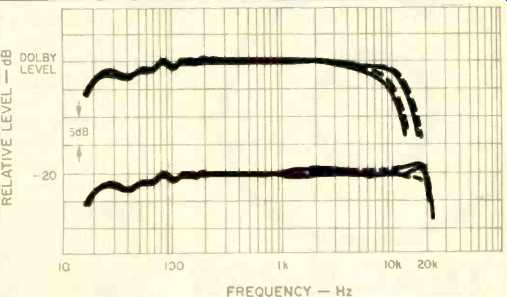
Fig. 4--Frequency responses with Denon DXM tape with and without (---)
Dolby NR.
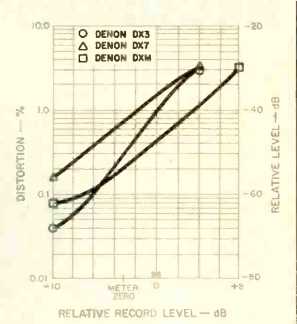
Fig. 5--Third harmonic distortion vs. level in Dolby mode at 1 kHz with
Denon DX3, DX7 and DXM tapes.
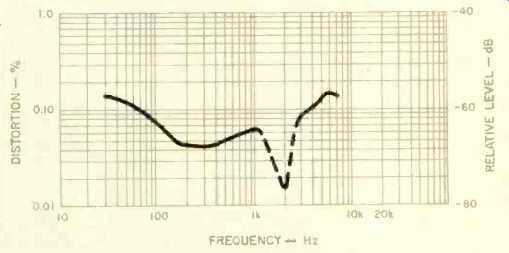
Fig. 6--Third harmonic distortion vs. frequency in Dolby mode at 10
dB below Dolby level with Denon DXM tape.
Use and Listening Tests
Loading and unloading, cleaning and demagnetizing were all easy tasks with this front-loading deck. All of the tape-motion switches performed without any sort of malfunction, whatever was tried. It was a pleasure to use this go-to-any-function de sign, and Cue was an added plus at times. Setting levels v is quite easy with the high-legibility meters and the peak-responding LEDs. The bias trim control was of continual value, and the FeCr tape-select option allowed trying some tapes not easily used on other decks.
The owner's manual has all of the basic information needed, but some of the text would benefit from a rewrite. A bias setting vs. tape chart is a worthwhile inclusion, but its value would be greatly increased if the listing were more in accordance with the formulations available in this country.
A series of listening tests were conducted using a variety of sources including discs and pink noise. The records were some of the dbx-encoded issues and Mobile Fidelity Sound Lab's offerings, such as Respighi's Feste Romane with Maazel and the Cleveland Orchestra, and Genesis and A Trick of the Tail. There was excellent sound with all of the tapes, and several times I noted a very pleasant, though slight, increase in presence with Dolby NR.
As expected, DXM stood out in the area of high recording levels with minimum negative effects. Record mute was judged to be a good scheme. Timer start had about a 3-second delay after power turn-on. No record or pause clicks were detected, and stop sounds were down in tape noise. The Denon DR-330 has very good to excellent performance in most all categories, and it compares very favorably with other units in the same and higher price ranges.
--Howard A. Roberson
(Source: Audio magazine, Mar. 1982)
Also see: Ferrograph Super Seven Model 7504-AHW 4-Track Tape Deck (Mar. 1975)